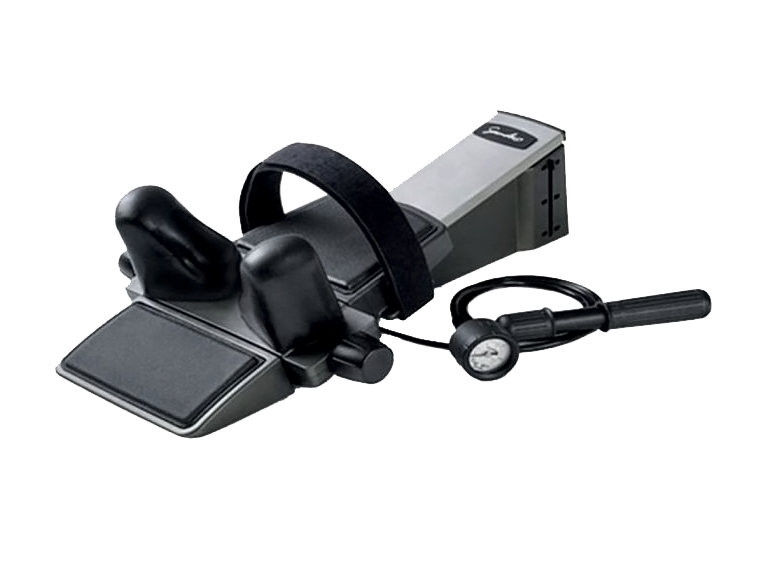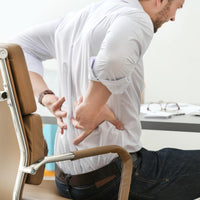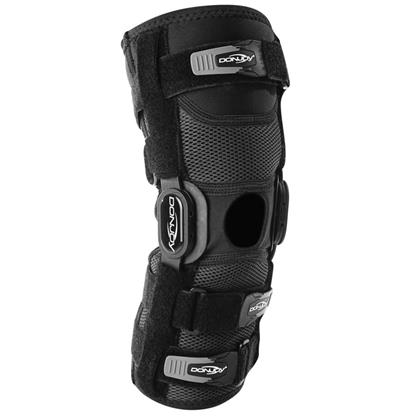
Anyone dealing with knee pain or recovering from knee surgery knows just how hard it is to find relief. Between resting, icing, and stretching, it can feel like your whole life revolves around managing your pain and getting through the day. A knee brace can be a simple, effective way to find relief, but you need to make sure you’re wearing your brace properly in order to see any benefits from it.
So, how long should you wear a knee brace in a day to maximize its effectiveness? It’s a question everyone using a knee brace asks at some point, but the answer isn’t always so simple! It’s important to understand how long to wear a knee brace so that you can heal as quickly as possible and live life without limitations. Today, we’ll help you understand how long to wear a knee brace and the factors that influence this decision.
Armed with this knowledge, you’ll be able to use a knee brace as a key part of your rehab to quickly and safely get back on your feet, and leave knee pain behind for good.
Is it Ok to Wear a Knee Brace All Day?
The idea of wearing a knee brace all day may seem tempting, especially if you're seeking continuous relief from persistent knee pain. So, is it ok to wear a knee brace all day?
For some acute injuries or post-surgery recovery, wearing a knee brace all day may be recommended during the early phases of healing. In these cases, the brace provides crucial support, reduces stress on the knee joint, and aids in maintaining stability. However, as the healing progresses and mobility improves, you likely won’t need to wear your brace for as long.
Wearing your knee brace all day can also have downsides. One concern is muscle atrophy. By constantly depending on external support, the muscles around the knee may weaken over time, as they are not actively engaged in providing stability and support. This can lead to a loss of strength and potentially delay the overall recovery process.
It’s also important to think about your comfort. Wearing a knee brace for a whole day can cause friction, pressure points, and skin irritation. Make sure you check your skin's condition regularly, follow proper hygiene practices, and take breaks from wearing your brace to allow your skin to breathe.
So, is it ok to wear a knee brace all day? It depends on your specific situation and the stage of your recovery. If you’re not sure, it’s a good idea to ask your doctor or physical therapist, and make sure your skin isn’t suffering from too much knee brace use.
Factors Influencing How Long to Wear a Knee Brace
When determining how long to wear a knee brace, there are a few different factors you have to keep in mind. Let's explore the key considerations that influence how long to wear a knee brace, remembering that everyone’s healing journey looks a little bit different.
Type and Severity of the Injury
Acute injuries, such as ligament sprains or meniscus tears, may require a more extended period of brace support during the initial stages of healing. On the other hand, you might not need to wear a brace as long for mild strains or minor instability issues.
Doctor's Recommendation
Consulting with a healthcare professional is essential when deciding is it ok to wear a knee brace all day. Your doctor's expertise and understanding of your specific injury will help develop a personalized plan. They may recommend specific time frames for wearing the brace based on your diagnosis, the progress of your recovery, and any specific goals or limitations you may have.
Comfort and Fit of the Brace
A properly fitted brace that provides good support and stability can usually be worn for longer periods without discomfort. On the other hand, an ill-fitting brace can be uncomfortable, cause skin irritation, or impede proper blood circulation. Make sure your brace is the right size and shape for your knee.
Individual's Lifestyle and Physical Activity Levels
If you lead an active lifestyle or participate in sports or activities that place significant stress on the knee, wearing a brace during those periods of high activity may be beneficial. However, if your activities are less strenuous or involve minimal knee strain, wearing the brace for shorter durations or as needed may be enough to help relieve the pain.
Progress of Recovery
As your knee recovers and gains strength, your doctor may change their recommendations around how long you should wear your knee brace. Your healthcare provider will monitor your progress and may gradually decrease the recommended duration as your knee stability improves. Make sure you communicate any changes in your symptoms or mobility to your doctor, so they can make adjustments as needed.
So, How Long Should You Wear a Knee Brace in a Day?
Ok, so how long should you wear a knee brace in a day? It of course varies depending on your unique circumstances, but here are some general recommendations you can use to get the most out of your knee brace.
General Recommendations
In the initial stages of recovery or following a knee injury, wearing a knee brace for 2 to 4 hours at a time can provide good support and stability. Gradually, as your knee strengthens and the healing progresses, you may not need to wear your brace for as long. Your healthcare provider will be able to provide personalized recommendations based on your injury, progress of recovery, and specific goals.
Suggestions for Gradual Increase/Decrease in Usage
When increasing or decreasing how long to wear a knee brace, it’s best to do this gradually. For example, if you've been wearing the brace for 2 hours at a time, you can gradually extend the duration by 30 minutes to 1 hour every few days. This allows your knee to adapt while minimizing the risk of muscle atrophy and promoting a progressive recovery.
When reducing the duration of brace wear, you can follow a similar gradual approach. Decrease the duration by 30 minutes to 1 hour every few days, while closely monitoring your knee's response and consulting with your healthcare provider. This helps your knee regain its natural stability and strength, gradually and safely.
Importance of Listening to Your Body & Treatment Provider
While guidelines can be helpful, it’s essential to listen to your body's signals and work in collaboration with your healthcare provider. Pay attention to any discomfort, pain, or changes in your knee's stability during and after wearing the brace.
If you do notice any changes, let your treatment provider know so that they can adjust the duration or suggest modifications to optimize your recovery. Regular check-ins and open communication with your provider will ensure that your knee brace usage is on track to facilitate the most effective recovery possible.
Should You Sleep With a Knee Brace On?
As well as learning how long should you wear a knee brace in a day, it’s also important to think about what you’re going to do with your knee at night. Sleeping with a knee brace is a topic that often raises questions and uncertainties. Let's explore the pros and cons of sleeping with a knee brace, and whether this is a good option for you and your knee.
Pros of Sleeping With a Knee Brace
For people with significant knee instability or those recovering from certain injuries or surgeries, wearing a knee brace during sleep can provide added stability and support. It can help prevent unwanted movements, minimize pain, and promote more restful sleep.
In some cases, usually after knee surgery, healthcare professionals may recommend wearing a knee brace during sleep to maintain proper alignment and protect the surgical site. This can aid in the healing process and contribute to faster recovery.
Cons of Sleeping With a Knee Brace
Wearing a knee brace for an extended period, including during sleep, can cause discomfort and skin irritation. The straps or padding may also dig into the skin, leading to further discomfort or disturbed sleep.
Also, wearing a knee brace while you sleep may impede proper blood circulation around the knee area. This can result in numbness and tingling sensations, and may slow down your healing.
Best Practices for Sleeping With a Knee Brace
Always talk to your healthcare provider before deciding to sleep with a knee brace. They can evaluate your specific condition, discuss potential benefits and risks, and provide personalized recommendations based on your recovery progress.
Also, make sure that the knee brace fits properly and comfortably. Adjust the straps to a snug but not overly tight position to avoid discomfort or restricted blood flow. Regularly check your skin for any signs of irritation or dryness, and consider using additional padding or cushioning if necessary.
If your healthcare provider recommends transitioning away from wearing the knee brace during sleep, reduce your use gradually and monitor your knee's response as you go.
Beyond How Long to Wear a Knee Brace, These Key Considerations Influence Your Path to Recovery…
How long should you wear a knee brace in a day is an important question to answer, but it’s not the only factor to consider when it comes to using a knee brace for your recovery. Let’s explore some of the other things that can help your knee recover at record speed.
The Specific Knee Brace You Wear
The first thing that’s important to realize is that not all knee braces are designed equal. Investing in a quality knee brace from a reputable brand like a Breg knee brace can make a huge difference in how quickly and safely your knee can recover. The Breg Fusion knee brace is a great place to start, as it is carefully engineered for both functional and post-surgical support.
Another great option is a Donjoy knee brace, which is perfect for rehabbing injuries or minimizing the pain associated with certain knee conditions. A knee brace with ice is the most effective way of combining both cold and compression therapy to help your healing - check with your doctor to see if this is the right choice for you.
Regular Exercise and Physical Therapy
Adding regular exercise and physical therapy to your treatment plan is vital for restoring strength, flexibility, and range of motion in your knee. Your healthcare provider or physical therapist can develop a tailored exercise program that focuses on strengthening the muscles surrounding your knee, improving joint stability, and promoting overall functional recovery. Make sure you stick to it - it can make a huge difference to your recovery!
Adequate Rest and Nutrition
Getting plenty of rest allows your body to heal and regenerate, supporting the recovery process. A balanced diet rich in nutrients gives you the necessary fuel for tissue repair and promotes overall well-being. Consult with a healthcare professional or nutritionist to make sure you're following a healthy and nourishing diet that supports your recovery goals.
Regular Check-ups and Follow-ups with the Doctor
Seeing your doctor regularly is crucial for monitoring your progress, assessing the effectiveness of your treatment plan, and making any necessary adjustments. These appointments allow your healthcare provider to evaluate your knee's healing, address any concerns or complications, and provide guidance and support throughout your recovery journey.
Speed Up Your Recovery and Get Back to Full Form With These Other Treatments
A knee brace is a great first step, but it’s not enough to heal your knee when used alone. At Ortho Bracing, we have an incredible selection of top-quality equipment and products to aid your rehab or recovery and get you back to full form in no time. With lower prices than you’ll find from your doctor’s office, 24/7 customer support, and next-day shipping, there’s no better place to get your rehab supplies!
You can complement your knee brace by adding electrotherapy benefits to your recovery routine. Check out our Chattanooga electrotherapy unit or Chattanooga ultrasound machine for reliable, clinical-grade devices that can make a real difference to your recovery.
If you’re wondering how to reduce post-surgery swelling, or when should you use cold therapy, you can find the best cold therapy machines right here at Ortho Bracing. Learn how to use Breg Polar Care Cube for knee recovery, and explore our incredible catalog of Breg products to find everything you need to get back on your feet as quickly as possible.
Positive Attitude and Patience
Healing takes time, and setbacks or challenges may arise along the way. It’s not always easy to stay positive during the tough times, but being upbeat can help you stay motivated and focused on your goals.
Patience also allows you to navigate the ups and downs of recovery without becoming discouraged. Trust in the process, follow your healthcare provider's guidance, and celebrate each milestone achieved along the way.
Closing Thoughts on How Long to Wear a Knee Brace
So, how long should you wear a knee brace in a day? Everyone’s recovery looks a little bit different, so it’s hard to provide an exact answer on how to fit a knee brace into your rehab. Use the tips in this article to guide you, and discuss the specifics with your doctor or physical therapist to make sure you’re getting the most out of your knee brace.
At Ortho Bracing, we not only have knee braces from all the leading brands, but we also stock everything else you need to make your rehab and recovery as fast and painless as possible. You’ll be amazed by what a difference the right equipment can make when it comes to getting back on your feet.
So, what are you waiting for? Find everything you need at Ortho Bracing for the smoothest, safest recovery possible.

































